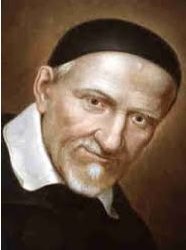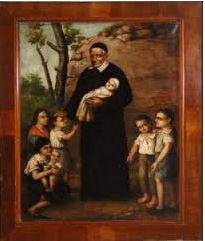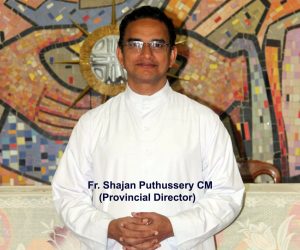Our Holy Founders- St. Vincent de paul and St. Louise De Marillac.

St.Vincent de Paul
St. Vincent De Paul was born in Pouy, Landes, Gascony, France, on April 24, 1581 to a family of peasant farmers. In his family Vincent had four brothers and two sisters. He studied theology at the University of Toulouse, was ordained a priest at 19, and completed a further year of studies in Rome, before returning to Paris and dedicating himself to serving the poor. By 1625 he had influenced a number of young men, some of them priests, to join him in forming a religious group to be called the Congregation of the Mission often known as “The Vincentians”.


St. Vincent de Paul was a skilled net-worker and collaborator and gave his energies and life to the needs of the poor in 17th-century war-torn France. Together with St. Louise de Marillac, a talented and sensitive friend, he organized hospitals for the sick poor, founded institutions for abandoned children, opened soup kitchens, created job training programs, taught young women to read, bettered prison conditions, and organized countless local charities in the villages throughout France. Vincent de Paul was canonized in 1737 and is popularly known as “The Father of The Poor.” With St. Louise de Marillac, he started the first religious group of women dedicated entirely to works of charity outside the cloister, a group called the Daughters of Charity.
Vincent was a man of action rather than of theory. He was a pragmatist and his spirituality was simple, down-to-earth and practical. He looked to Christ as his leader and tried to translate the Gospel message into concrete results.
Besides being a practical organizer he was also a man of deep faith; a man of prayer and a mystic. The immense range of services he set up for the poor were more than mere philanthropy. They were rooted in the Gospel vision of Matthew 25 where Jesus tells us:
“Whatever you do to the least of my brothers and sisters you do it to me”.
Foundation of Two Congregations
Congregation of the Mission, 1625(CM) and The Daughters of Charity of st. Vincent de paul, 1633(DC)
and A Lay Organization named Confraternities of Charity, 1617. Today Known as (AIC) International Association of Charity.

In 1617, Vincent founded the “Confraternities of charity” (French: Dames de la Charité) from a group of women within his parish. He organized these wealthy women of Paris to collect funds for missionary projects, found hospitals, and gather relief funds for the victims of war and to ransom 1,200 galley slaves from North Africa. From these, with the help of St. Louise de Marillac, came the Daughters of Charity of Saint Vincent de Paul (French: Filles de la Charité).
In 1622 Vincent was appointed chaplain to the galleys. After working for some time in Paris among imprisoned galley-slaves, he returned to be the leader of what is now known as the Congregation of the Mission, or the “Vincentians”. These priests, with vows of poverty, chastity, obedience and stability, were to devote themselves entirely to the people in smaller towns and villages.
Vincent was zealous in conducting retreats for clergy at a time when there was great laxity, abuse, and ignorance among them. He was a pioneer in clerical training and was instrumental in establishing seminaries.
Vincent died on Sept. 27, 1660, and was canonized a saint in the Roman Catholic Church in 1737.
Veneration

In 1705, the Superior-General of the Lazarists requested that the holy process of Vincent’s canonization be instituted. On 13 August 1729, he was declared blessed by Pope Benedict XIII. He was canonized nearly eight years later by Pope Clement XII on 16 June 1737.
Vincent’s body was exhumed in 1712, 53 years after his death. The written account of an eyewitness states that “the eyes and nose alone showed some decay”. However, when it was exhumed again during the canonization in 1737, it was found to have decomposed due to an underground flood. His bones have been encased in a waxen figure which is displayed in a glass reliquary in the chapel of the headquarters of the Vincentian fathers in Paris. His heart is still incorrupt, and is displayed in a reliquary in the chapel of the motherhouse of the Daughters of Charity in Paris.
Vincent is honored with a feast day on 27 September in the Church .
Foundress

In 1885, Pope Leo XIII named Vincent patron of the Sisters of Charity. He is also patron to the Brothers of Charity.
Vincent is the patron of all works of charity. The Society of Saint Vincent de Paul, a charitable organization dedicated to the service of the poor, was established by French university students in 1833, led by the Blessed Frederic Ozanam. The Society is today present in 132 countries.
St. Louise de Marillac

Born in 1591, Louise was illegitimate and never knew who her mother was but was acknowledged and raised by her father, a member of the aristocracy. When her father married, Louise had a difficult time adjusting as was sent as a resident student to a Dominican convent where her aunt was a religious. This experience deepened Louise’s introspective ways, her many intellectual skills, as well as her desire to be a religious. When her father died and resources were limited, she lived in a boarding house where she had the opportunity to learn many basic domestic and organizational skills. This experience rounded out her classical, upper-class education and prepared her well for her future service.
Louise married Antoine le Gras, secretary to the Queen of France, but their marital happiness was short-lived because of his poor health. As a young matron, Louise travelled and socialized among both the royalty and aristocracy of France, but she was equally comfortable with the poor, no matter how their desperate situations. She held a leadership role in the Ladies of Charity, an organization of rich women dedicated to assisting the poor.

Suffering was never far from Louise. During civil unrest, her two uncles who held high rank within the government were imprisoned. One was publicly executed and the other died in prison. In 1623, when illness was wasting Antoine who died in 1625, depression was overcoming Louise. While at prayer, Louise had a vision in which she saw herself serving the poor and living the vows of religion in community. She wrote this “lumiere” on parchment and carried it on her person as a reminder that despite her difficulties, God was guiding her life. In that vision a priest appeared to her, whom she later identified as Vincent de Paul, her future confidante and collaborator in ministry
n 1629, Vincent de Paul, invited Louise to assist him in the parishes of France. These tasks were therapeutic for Louise and formative for her future work and that of the Vincentian family. She conducted site visits to assure the quality of the service being offered; reviewed financial accounts for stewardship reports; and encouraged the workers and volunteers to see Christ in those whom they served.
Through this work, she gained a deep knowledge of the needs of the poor, developed her own innate management skills and identified effective structures for service. On November 29, 1633 in her own home she began to train young women to address the needs of the poor and to gain support from their life together. From this humble beginning, the community of Daughters of Charity emerged. Louise provided leadership and expert management to the evolving network of services she and Vincent inspired.

Louise, who died on March 15, 1660 just a few months before Vincent de Paul, was proclaimed a Saint of the Church in 1934. In 1960 Pope John XXIII proclaimed her the Patroness of all Social Works. As a wife, mother, teacher, nurse, social worker and religious foundress, she stands as a model to all women. She lives today in the 17,000 Daughters of Charity serving throughout the world, as well as in their many lay collaborators.
